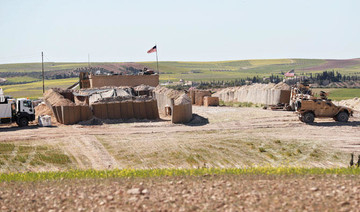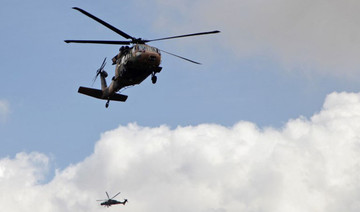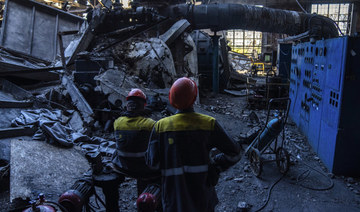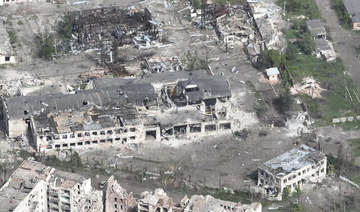ANKARA: Nine people were killed and nearly 50 injured after a high-speed train crashed into a locomotive in the Turkish capital on Thursday, officials said.
Transport Minister Cahit Turhan told reporters in televised remarks that three of those killed were operators of the train.
One of the victims died in hospital, he added.
Turhan added that 47 people were injured and were in hospital for treatment.
The fast train had been on its way from Ankara’s main station to the central province of Konya and according to Hurriyet daily, there were 206 passengers on board.
Earlier, the Ankara governor’s office said three out of a total of 46 people had been seriously injured.
The death toll was rising fast. Ankara governor Vasip Sahin said earlier on Thursday morning that four people had been killed.
“This morning there was an accident after the 6.30 high-speed train to Konya hit a locomotive tasked with checking rails on the same route,” Sahin told reporters in televised remarks.
Turhan said the accident took place six minutes after the train left Ankara as it entered the Marsandiz station.
The governor said search and rescue efforts continued as “technical investigations” were underway to find out exactly what caused the crash in Yenimahalle district.
He said information about the cause of the crash would be shared with the public when it is known.
Images published by Turkish media showed some wagons had derailed and debris from the train scattered on the rail track, which was covered in snow.
The windows of one wagon were completely broken while another wagon had been smashed after hitting the footbridge, which also collapsed, an AFP correspondent at the scene said.
The Ankara public prosecutor launched an investigation into the crash, state news agency Anadolu reported.
The Ankara to Konya high-speed route was launched in 2011 and was followed in 2014 with a high-speed link between Ankara and Istanbul.
The accident comes after another rail disaster in July this year when 24 people were killed and hundreds more injured after a train derailed in Tekirdag province, northwest Turkey, due to ground erosion following heavy rains.
Turkey’s rail network has been hit by several fatal accidents in recent years.
In March 2014, a commuter train smashed into a minibus on a railway track in the southern Turkish province of Mersin, which left 10 dead.
In January 2008, nine people were killed when a train derailed in the Kutahya region south of Istanbul because of faulty tracks.
Turkey’s worst rail disaster in recent history was in July 2004 when 41 people were killed and 80 injured after a high-speed train derailed in the northwestern province of Sakarya.
Ankara train crash leaves nine dead, 47 injured
Ankara train crash leaves nine dead, 47 injured
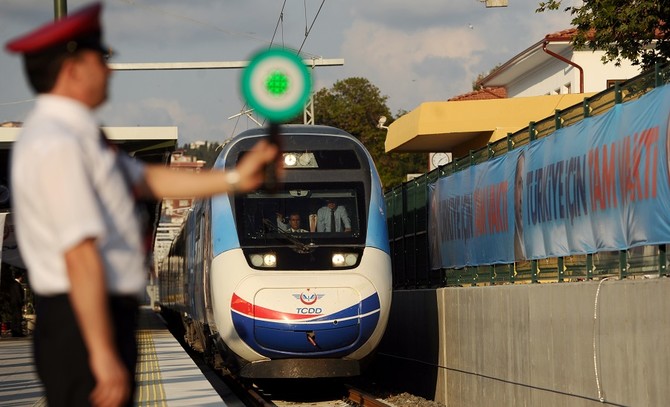
- 47 others were injured in the train crash, according to the Ankara governor
- The high-speed train crashed into a locomotive which carries out track inspections
Iraqi militant group claims missile attack on Tel Aviv targets, source says
BAGHDAD: The Islamic Resistance in Iraq, a group of Iran-backed armed groups, launched multiple attacks on Israel using cruise missiles on Thursday, a source in the group said.
The source told Reuters the attack was carried out with multiple Arqub-type cruise missiles and targeted the Israeli city of Tel Aviv for the first time.
The Islamic Resistance in Iraq has claimed dozens of rockets and drone attacks on US forces in Iraq and Syria and on targets in Israel in the more than six months since the Israel-Hamas war erupted on Oct. 7.
Israel has not publicly commented on the attacks claimed by Iraqi armed groups.
The Islamic Resistance in Iraq, a group of Iran-backed armed groups, launched multiple attacks on Israel using cruise missiles on Thursday, a source in the group said. (AFP/File)
Little hope of Ukraine breakthrough during Xi France visit: observers

- “France and the European Union expect him to use his influence on Russia, but Xi Jinping has nothing to offer on Ukraine,” said a former European diplomat
- Xi is due to make a state visit to France on Monday and Tuesday
PARIS: French President Emmanuel Macron will next week make a new push to try and dissuade China’s Xi Jinping from supporting Russian President Vladimir Putin’s war against Ukraine but is unlikely to make a breakthrough on ending the conflict during the visit, observers say.
President Xi’s visit is set to be rich on symbolism — with a sumptuous dinner at the Elysee Palace and a trip to the Pyrenees mountains planned — but risks being short on diplomatic success for the French leader.
“France and the European Union expect him to use his influence on Russia, but Xi Jinping has nothing to offer on Ukraine,” said a former European diplomat, asking not to be named.
Xi is due to make a state visit to France on Monday and Tuesday, followed by visits to Serbia and Hungary, two European countries retaining warm ties with Russia.
While Xi and Macron will discuss international crises, trade, climate change and cultural exchanges, the key aim will be to “point out that for Europe, the first issue with China is its position on Ukraine,” said a source close to the French government.
On a visit to China in 2023, Macron had already called on Xi to “bring Russia to its senses” over Ukraine and urged him not to deliver weapons to Moscow.
Little has changed, however. Xi will host Putin for talks in China later this month.
Macron, 46, indicated he had not given up on the idea of trying to get Xi, 70, on his side.
“It’s not in China’s interest today to have a Russia that destabilizes the international order,” the French president said in an interview with The Economist published on Thursday. “We need to work with China to build peace.”
European Commission President Ursula von der Leyen, who has urged Beijing to play a greater role in ending the Ukraine war, will join Macron and Xi for talks on Monday.
Macron has said he will ask the Chinese president to help him achieve that aim when he visits Paris, which is preparing to host the Olympic Games this summer.
There is a historic tradition that peace should reign during the Olympics — although the opening of the Games in Beijing in August 2008 did not halt Russia’s invasion of Georgia.
“On Ukraine, China has done nothing,” said Marc Julienne, director of the Center for Asian Studies at the French Institute of International Relations (IFRI).
In February 2023, China published a 12-point position paper on Ukraine, but it was rejected by Kyiv and its Western allies.
Beijing, which says it is a neutral party in the Ukraine conflict, has been criticized for refusing to condemn Moscow for its offensive.
The United States had accused China of helping Russia carry out its biggest militarization since Soviet times.
US officials say China has provided dual-use supplies that have let Russia regroup in the face of a long delay in US aid to Ukraine.
In April, US Secretary of State Antony Blinken said this included “machine tools, semiconductors, other dual-use items that have helped Russia rebuild the defense industrial base that sanctions and export controls had done so much to degrade.”
China has rejected the US claims as “groundless accusations.”
Macron, too, is expected to raise “concerns” about “the activity of certain Wuhan companies that could be directly involved in or contribute significantly to the Russian war effort,” according to a member of his team.
Beijing is a major supporter of the Russian economy.
China-Russia trade in 2023 reached a record $240 billion, according to customs data, overshooting a goal of $200 billion set by the neighbors.
Experts say Beijing is unlikely to renounce support for Moscow, which it sees as a priority partner in its opposition to the United States.
“Xi Jinping’s priority is the Global South,” said Emmanuel Lincot, a China expert at the Catholic University of Paris.
“There is a congruence in the Sino-Russian bilateral relationship, particularly in the desire to counter the West. Which is not to say that there is no rivalry.”
Lebanese security forces arrest ‘TikTok influencer’ using platform to lure, assault minors

- Lebanese police say they arrested six, including three minors, involved in sexual assaults against minors
LONDON: Lebanese authorities arrested on Wednesday six people for their alleged involvement in sexual assaults on children, sometimes using the video-sharing platform TikTok to lure minors.
The Internal Security Forces said in a statement that among those arrested was a “TikTok influencer,” who is also a hairdresser, according to local media.
The six suspects are reportedly part of a criminal network comprising around 30 individuals involved in assaults against at least 30 children.
The Lebanese police said in a statement that “based on information obtained by the Cybercrime Bureau of the Judicial Police, and following a complaint lodged by a number of minors with the Public Prosecutor’s Office concerning sexual assaults, compromising photos and incitement to take drugs by members of a gang, the bureau in question has been able to arrest, to date, six people in Beirut, Mount Lebanon and North Lebanon.”
The arrested suspects also include three minors of Lebanese, Turkish, and Syrian nationalities who were active on TikTok, according to the statement.
Highlighting that the case has been probed for about a month, the Lebanese police vowed that “the investigation is continuing with a view to arresting all members of the gang.”
The head of the network, a famous TikTok personality, purportedly abused his fame and invited children to shoot TikTok videos with him, the independent Lebanese TV channel Al-Jadeed reported.
The TikToker would cut the children’s hair to gain their trust before inviting them to a party, where his accomplices sexually assaulted the children.
Moroccan photographer Hassan Hajjaj captures the culture of AlUla

- The acclaimed Moroccan photographer discusses his recent show in Saudi Arabia
DUBAI: Early in February this year, Moroccan contemporary artist and photographer Hassan Hajjaj was given a reminder of just how high his star has risen. Within a few days of each other, Hajjaj had shows opening in the US, Morocco, and — as part of AlUla Arts Festival — Saudi Arabia.
Hajjaj’s playful portraiture, which incorporates vivid color, funky clothing (almost all of which he designs himself), geometric patterns, and — often — vintage brands from the MENA region, has made him internationally popular, and his instantly recognizable style has established him as one of the world’s leading photographers.
His show in AlUla consisted of images that he shot in the ancient oasis town in February 2023. That visit was initially supposed to involve shoots with around 20 local people. It’s the kind of thing he’s done a few times before, including in Oman and Abu Dhabi. “It’s always a good opportunity to get to know the culture and the people,” Hajjaj tells Arab News.
But, as he says himself, he arrived in AlUla as “an outsider,” so needed a team on the ground to persuade locals to come and sit (or stand, in most cases) for him.
“It was a bit tough, in the beginning, for them to find people,” Hajjaj explains. “But because it was during a period when lots of art things were happening in AlUla, there were lots of people coming from outside AlUla as well. So we opened it up. I basically said, ‘Just come.’
“In the end lots of people turned up, not just locals — people from Riyadh, Jeddah, and people (from overseas) too. I think I shot around 100 people over a few days. So it was a great opportunity,” he continues. “To get to shoot that many people over three days — organizing something like that for myself might take a year. So, as long as I have the energy, when I get these opportunities — you know, I’m in AlUla with this eclectic bunch of people — I’d rather go and grind it, really work hard, and have that moment.”
A Hassan Hajjaj shoot isn’t your regular portrait shoot, of course. “It’s almost like a performance,” he says. “There’s music, people dress up, it’s like a day out for them, taking them out of themselves for a few hours.”
He followed the same modus operandi in AlUla. “We got an ambience going. It was fun, there was music… I shot in this beautiful old school that was one of the first girls’ schools in Saudi Arabia, from the Sixties. Upstairs was like a museum — everything was like a standstill from the Seventies and Eighties; even the blackboards had the chalk and the writing from that time,” he says.

A crucial part of Hajjaj’s practice is to ensure that his subjects are at ease and feel some connection with him (“comfortable” is a word he uses several times when talking about his shoots). While all his portraits bear his clearly defined style, it’s important to him that they should also show something unique to the people in them.
“It’s that old thing about capturing the spirit of the person in that split second, you know? I’m trying to get their personality and body language in the image,” he says. “Quite often I’m shooting in the street, outdoors, so (the subjects) can start looking at other people, thinking, ‘Are they looking at me?’ So I usually say, ‘Listen. This is a stage I’m building for you. I’m dressing you up, and we’re going to have fun.’ Then I just try and find that personality that can come out and make the image stronger. With some people, though, saying almost nothing can be better — just getting on with it. I try to kind of go invisible so it’s the camera, not the person, that’s doing the work. The best pictures come out when there’s some kind of comfortable moment between me and the person and the camera.”
It’s the way he’s worked since the beginning — a process that developed organically, as most of his early portraits were of “friends or friends of friends.”

“There’s a comfort in that because you have a relationship with them. It made it easy,” he says. “And that taught me about how important it is to build trust with people to get into that comfortable zone. But as time went on, obviously, people could see the stuff in the press or on social media, so then people started, like, asking to be shot in that manner; maybe they’ve studied the poses of certain people and stuff like that, so they come ready to do some pose they’ve seen in my pictures. That’s quite funny.”
The work that was on display over the past two months in Hajjaj’s “AlUla 1445” is a perfect example of what he tries to achieve with his shoots. The images are vibrant, playful, and soulful, and the subjects run from a local goatherder through the AlUla football team to bona fide superstars: the US singer-songwriter Alicia Keys and her husband Swizz Beatz.
Hajjaj says he has a number of favorites “for different reasons,” including the goatherder.

“He brought in two goats and it became quite abstract when you put all of them together. I was playing with that notion of the person; you could see that’s his life and even the goats look happy,” he explains. “I wanted to make sure they had that shine in the image as well. I got some great shots of him.”
The Alicia Keys and Swizz Beatz shoot has been a long time in the making. Hajjaj first met Swizz Beatz a decade ago, and they have been in touch intermittently ever since. The idea of a shoot with Keys first came up about five years ago, but logistics had always got in the way. But since they were playing a concert in AlUla at the same time as Hajjaj was there, it finally happened, on Hajjaj’s last day, with perhaps an hour left before the light faded.
I ask Hajjaj if his approach to shooting celebrities differs from his shots of “ordinary” people.

“There’s probably not that much difference,” he says. “They’re coming into my world, so, again, it’s just making sure they’re comfortable with you and you’re comfortable with them; not looking at them (as celebrities). The only thing is you have to imagine they’ve been shot thousands of times — by top photographers, too — so they’re going to have their ways. So I just have to lock in with them and find that comfortable space between the sitter and me.”
And then there’s Ghadi Al-Sharif.
“It’s a beautiful picture. She’s got this smile, with her hand over her face. For me, that one really presents the light and the energy of AlUla,” Hajjaj says. “It captures the new generation.”
Global advocacy group says over 300 journalists faced state repression in Pakistan in one year

- International Federation of Journalists says 8 media workers were charged for sedition, terrorism, incitement to violence
- It mentions the plight of Afghan journalists in exile, safety issues of Pakistani women journalists in online and offline spaces
ISLAMABAD: A leading global advocacy group for journalists’ rights on Friday highlighted alarming challenges faced by the media in Pakistan on Friday, saying that more than 300 people associated with the information industry faced repressive state tactics designed to quell dissent during the course of about a year.
The International Federation of Journalists (IFJ) released its country report on Pakistan on World Press Freedom Day that falls on May 3.
The report highlighted the persistent threats to freedom of expression, safety concerns, gender inequality, and the impact of disinformation on the local media industry.
“Over 300 journalists and bloggers this year were affected by state coercion and targeted, including dozens of journalists arrested for durations between several hours to four weeks and nearly 60 served legal notices or summons for their journalism work or personal dissent online,” the IFJ Pakistan country report for 2023-2024 said. “At least eight were charged for alleged sedition, terrorism and incitement to violence – all serious charges carrying lengthy sentences and even the death penalty.”
It maintained that most of these cases stemmed from the perceived or actual support of these journalists for former prime minister Imran Khan and his political party.
“In this sense, the principal threat actor behind crimes against journalists and free speech practitioners was undoubtedly the state and its functionaries, though some regional sects, non-state actors and gangsters were also involved in some cases,” the report added.
The IFJ described the judicial intervention in these matters as “the silver lining,” saying it thwarted the government’s attempts to entangle journalists “in legal proceedings as a tool of deterring dissent.”
The report noted four journalists were killed during the period under review while at least 59 journalists and bloggers were charged with sedition, terrorism, incitement to violence, defamation or contempt.
“Of these, 47 journalists were served legal summons to respond to allegations of targeted defamation and incitement against judges of the superior judiciary,” it continued.
The report also maintained the safety of women journalists in Pakistan’s online and offline spaces remained a persistent challenge.
“They continued to face gender-based discrimination, journalism work-related intimidation and under-representation in the industry,” it said.
The IFJ said this environment led to self-censorship among journalists and media outlets, especially while writing on topics concerning religion and law.
It also highlighted the plight of Afghan journalists, saying nearly 200 of them had fled to Pakistan after the Taliban takeover in August 2021.
“In October 2023, Pakistan’s government unilaterally demanded that Afghan refugees return to Afghanistan, setting a deadline of one month before authorities began forced deportations,” it recalled. “Amongst the refugees were 200 journalists who had fled to Pakistan to escape stifling restrictions on free speech in Afghanistan.”
The organization said it had called for financial and legal assistance for these journalists to support their sustenance and freedom to report.



